Legislative Day
Tomorrow, January 30th is Legislative Day at the Georgia Capitol. This is the day for lawmakers to meet with their local constituents. Please remember all of the Pike County Chamber members and business people, who are going on behalf of the businesses of Pike County.
DIY Pantry
 Mallory of Classy Clutter fit a rolling pantry in the 6-inch space between her refrigerator and wall. All images in this post: Classy Clutter
Mallory of Classy Clutter fit a rolling pantry in the 6-inch space between her refrigerator and wall. All images in this post: Classy Clutter
Finding hidden storage in the kitchen is always a treat. That’s why we’re sharing Classy Clutter’s rolling pantry, which gives slivers of space new purpose.
Mallory (half of the Classy Clutter team) built the portable pantry to fit the 6-inch space between her refrigerator and wall — a common underused place in many kitchens.
The neat thing about this project is that it’s adjustable. You can make it as big or small as you need. And it’s totally DIYable if you have basic skills with a drill, hammer, and screwdriver.
Here’s what else you’ll need:
- Wood boards — Mallory used primed pine (about $15/ft. for 1-in. x 4-in.)
- Dowels to hold cans in place ($1.50 for 1/2-in. by 4 ft.)
- Sheet of beadboard (75 cents/sq. ft)
- 4 casters ($3 each)
- Handle or pull
Mallory has construction details, plus a handy diagram on her post about the project. Her rolling pantry was 64 inches high and 31.5 inches wide, and she only needed 7 shelves (9 were on the plan).
The other cool thing with this project is that you can jazz it up as much as you want. Mallory wanted the pantry to match her kitchen décor, so she spray-painted a blue-green chevron design on it, which made a really nice background for spices and soup cans.
Mallory says she got the idea on Pinterest. (We’ve been collecting other great ideas on our Perfect Pantry Projects page on Pinterest.)
Read more: http://www.houselogic.com/blog/kitchens/roll-out-pantry-small-kitchen/#ixzz2JL5ur95h
Unify Your Home in 8 Simple Design Areas
Here are eight features to create continuity with, from the big areas (flooring and paint) to the tiniest details.
|
1. Hard flooring. If you are redoing floors or choosing flooring for a new home, a great choice to make early on in the design process is to go with the same treatment throughout the space. You can maintain a sense of continuity even with several different flooring materials as long as they make sense together. For instance, try using stone or tile floors in the entry and mudroom, and wood floors in the rest of the space.
|
|
8. A clean backdrop. This cottage feels spacious and serene, thanks in great part to fresh white wall paneling throughout. It’s one of the oldest tricks in the book, but an all-white space really can work wonders.
|
12 Simple Home Repair Jobs to Lift You Out of Winter’s Funk
Accomplishments — even little ones — go a long way toward a sunny outlook. Fortunately, there are plenty of easy, quick home repair chores you can do when you’re mired in the thick of winter. For max efficiency, make a to-do list ahead of time and shop for all the tools and supplies in one trip. On your work days, put the basics in a caddy and carry it from room to room, checking off completed tasks as you speed through them.
What to look (and listen) for
In each room, look around and take stock of what needs fixing or improving. Focus on small, quick-hit changes, not major redos. Here are some likely suspects:
1. Sagging towel rack or wobbly toilet tissue holder. Unscrew the fixture and look for the culprit. It’s probably a wimpy, push-in type plastic drywall anchor. Pull that out (or just poke it through the wall) and replace it with something more substantial. Toggle bolts are strongest, and threaded types such as E-Z Ancor are easy to install.
2. Squeaky door hinges. Eliminate squeaks by squirting a puff of powdered graphite ($2.50 for a 3-gram tube) alongside the pin where the hinge turns. If the door sticks, plane off a bit of the wood, then touch up the paint so the surgery isn’t noticeable.
3. Creaky floor boards. They’ll shush if you fasten them down better. Anti-squeak repair kits, such as Squeeeeek No More ($23), feature specially designed screws that are easy to conceal. A low-cost alternative: Dust a little talcum powder into the seam where floorboards meet — the talcum acts as a lubricant to quiet boards that rub against each other.
4. Rusty shutoff valves. Check under sinks and behind toilets for the shutoff valves on your water supply lines. These little-used valves may slowly rust in place over time, and might not work when you need them most. Keep them operating by putting a little machine oil or WD-40 on the handle shafts. Twist the handles back and forth to work the oil into the threads. If they won’t budge, give the oil a couple of hours to penetrate, and try again.
5. Blistered paint on shower ceilings. This area gets a lot of heat and moisture that stresses paint finishes. Scrape off old paint and recoat, using a high-quality exterior-grade paint. Also, be sure everyone uses the bathroom vent when showering to help get rid of excess moisture.
6. Loose handles or hinges on furniture, cabinets, and doors. You can probably fix these with a few quick turns of a screwdriver. But if a screw just spins in place, try making the hole fit the screw better by stuffing in a toothpick coated with glue, or switching to a larger screw.
Safety items
You know those routine safety checks you keep meaning to do but never have the time? Now’s the time.
7. Carbon monoxide and smoke detectors. If you don’t like waking up to the annoying chirp of smoke detector batteries as they wear down, do what many fire departments recommend and simply replace all of them at the same time once a year.
8. Ground-fault circuit interrupter (GFCI) outlets. You’re supposed to test them once a month, but who does? Now’s a great time. You’ll find them around potentially wet areas — building codes specify GFCI outlets in bathrooms, kitchens, and for outdoor receptacles. Make sure the device trips and resets correctly. If you find a faulty outlet, replace it or get an electrician to do it for $75 to $100.
9. Exhaust filter for the kitchen stove. By washing it to remove grease, you’ll increase the efficiency of your exhaust vent; plus, if a kitchen stovetop fire breaks out, this will help keep the flames from spreading.
10. Clothes dryer vent. Pull the dryer out from the wall, disconnect the vent pipe, and vacuum lint out of the pipe and the place where it connects to the machine. Also, wipe lint off your exterior dryer vent so the flap opens and closes easily. (You’ll need to go outside for that, but it’s quick.) Remember that vents clogged with old dryer lint are a leading cause of house fires.
11. Drain hoses. Inspect your clothes washer, the dishwashers, and the icemaker. If you see any cracks or drips, replace the hose so you don’t come home to a flood one day.
12. Electrical cords. Replace any that are brittle, cracked, or have damaged plugs. If you’re using extension cords, see if you can eliminate them — for example, by replacing that too-short lamp cord with one that’s longer. If you don’t feel up to rewiring the lamp yourself, drop it off at a repair shop as you head out to shop for your repair materials. It might not be ready by the end of the day. But, hey, one half-done repair that you can’t check off is no big deal, right?
Read more: http://www.houselogic.com/home-advice/repair-tips/home-repair-jobs-winter/#ixzz2IZRy1A3Q
Small Business of the Year
Congratulations to McLeRoy Realty and it’s associates on being named Pike County’s Small Business of the Year!
Organization
Check out this link for lots of great information about getting and keeping your home organized!
Whimsy Meets Function in This $50 Pantry Redo
 Since she moves often, Christy Black wanted her pantry to be functional, reversible, and whimsical. All images in this post: Christy at 11 Magnolia Lane
Since she moves often, Christy Black wanted her pantry to be functional, reversible, and whimsical. All images in this post: Christy at 11 Magnolia Lane
Our first pantry transformation comes from Christy Black, a military wife who moves every couple of years. It’s a mixed blessing that forces her to constantly edit her possessions and question each purchase with: Is this something I love, need, and want to unpack?
Frequent moves also guided the way the 11 Magnolia Lane blogger added kitchen storage by making over the pantry in the 1915 colonial revival her family recently called home. The pantry project had to be:
- Reversible, for the next resident
- Functional to accommodate her prized bread machine
- Whimsical to provide little touches that makes each new rental feel like home
This is what Black’s “before” pantry looked like:
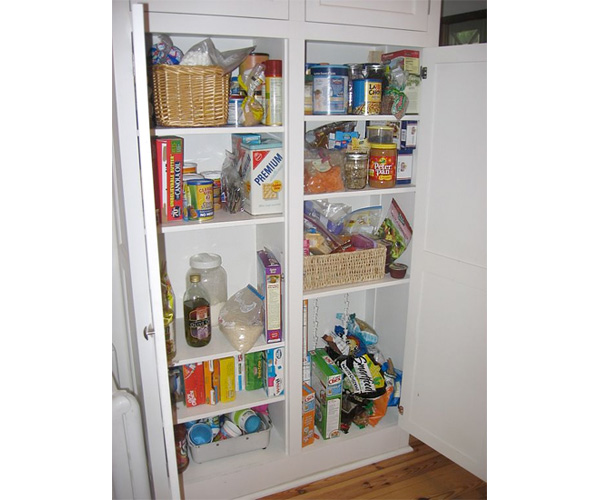
It was a two-door, built-in cabinet with adjustable shelves. The tallest items only halfway filled the tallest shelves (waste of space). Mounds of boxes and bags tumbled out when Black opened the doors.
“The pantry was the only storage I had for big boxes and small appliances, and nothing was deep enough or tall enough for them,” Black says. “And I hate things on the counters. I hate clutter.”
Pantry pare-down
Black started her pantry project by empting its contents onto floors and countertops.

Next, Black moved and removed shelves to customize the space to hold that bread machine and her favorite kitchen helper — a snacks rack her kids love and her friends covet. She snagged the rack on eBay, but you can buy one for about $37 online.
To corral half-filled pasta boxes and sloppy bags of beans, Black bought inexpensive glass canisters. She admits decanting everything into jars takes time, but jars look good, save space, and let her easily see what needs reordering. Of course, her glass canisters couldn’t hold a 25-pound of rice. So she stored bulk goods in the cellar, keeping the pantry for everyday items.
Pantry pizzazz
She glue-gunned a ½-inch wide, polka dot ribbon to the face of each shelf. If the next residents don’t like polka dots, she reasoned, they can easily remove the glue with a short blast from a hot hairdryer.
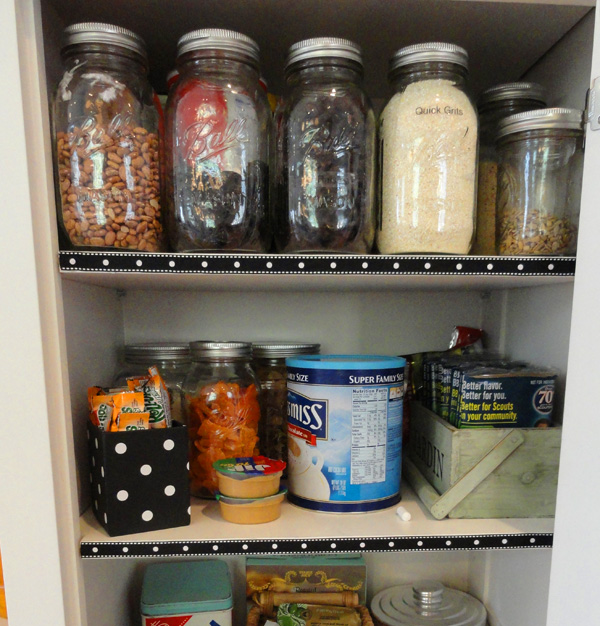
Black looked at the inside of the raised panel pantry doors and saw space that could answer her family’s perpetual question: What’s for dinner? She bought chalkboard contact paper ($7 for 18-in. by 6-ft. roll), and cut a panel for each door. On the left she wrote weekly menus; on the right she had a surface for her kids to doodle.
Chalkboard paint, which is easy to clean, would have worked better than paper, Black says. But paint isn’t reversible, which was a requirement for the pantry makeover.
Total cost: $50 (mostly for glass canisters)

To see more inspiring pantry storage ideas, visit our Perfect Pantry Projects Pinterest page.
Read more: http://www.houselogic.com/blog/kitchens/design-pantry/#ixzz2IZSwbgmn
Fiscal Cliff Win for Homeowners
The fiscal cliff deal Congress passed this week lets home owners keep the tax deduction for private mortgage insurance payments. It also says troubled home owners won’t owe income tax on amounts forgiven during a mortgage workout or foreclosure.
PMI is what you pay your lender each month if you put down less than 20% on a home, which protects the lender if you default on the home loan.
Without mortgage cancellation relief, home owners who have a portion of their mortgage forgiven as part of a workout plan, short sale, or foreclosure would have to pay income tax on the forgiven amount.
In addition, the American Taxpayer Relief Act of 2012 lets home owners continue to keep up to $500,000 ($250,000 for individuals) in home sale profits tax-free. Only home sellers whose income is $450,000 or above (or singles earning $400,000 or more) and who net more $500,000 on the sale of their home would pay taxes on the excess capital gains. For the vast majority of home sellers, there’s no change.
For those earning above the $400,000-$450,000 threshold, the cap gains rate would rise to 20% from 15%.
Congress extended the tax deductions for all mortgage insurance premiums and for state and local property taxes, which, along with the mortgage interest deduction, are important tax considerations for home owners and buyers.
Pet Projects That Repurpose Unwanted Stuff
 This old dresser drawer was upcycled into an eco-friendly pet bed. Image: StephanieJane Upcycle
This old dresser drawer was upcycled into an eco-friendly pet bed. Image: StephanieJane UpcycleToday is America Recycles Day, so we turned to some of our favorite online sites for penny-pinching repurposing ideas that will benefit cats and canines.
But before we dive in, keep the following in mind: When it comes to buying or making repurposed stuff for pets, make sure all materials are non-toxic and don’t pose a hazard to Spot or Kitty.
(If pets aren’t your thing, then check out yesterday’s post about repurposing burnt-out light bulbs, or come back tomorrow, when we’ll tell you how to repurpose leftover chopsticks and plastic containers from your takeout dinners).
One-of-a-kind pet beds
Most store-bought pet beds are eyesores. But something repurposed from old furniture or even an outdated consumer electronic makes a great conversation piece — in addition to a cool pet nook.
1. Dresser drawer pet bed: StephanieJane Upcycle, an Etsy seller, turned a drawer from a broken dresser into an eco-friendly pet bed. They kept animal and human wellness in mind while adding the final touches. The drawer was stripped and refinished using biodegradable and non-toxic products.
Recycling tip: There are organizations that specifically recycle broken furniture. To find a local solution for your broken stuff, visit Earth911.com.
2. A toaster oven pet bed: The Etsy shop Recycled Arts gave an outmoded kitchen appliance new life as a pet crash pad (albeit for pint-sized pets). A fleece blanket was added for comfort. And just for fun, they left the timer intact.
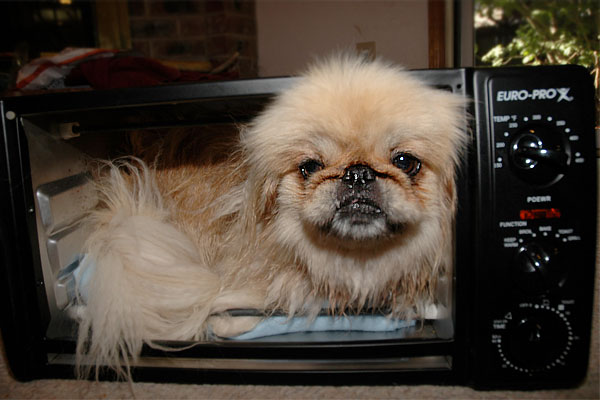
Credit: Julia Hosack/Linden Tree Photography
Recycling tip: Have a bunch of old blankets and linens that you want to get rid of? Donate them to your local animal shelter. By doing so, you’ll keep rescued dogs and cats warm this winter.
Fun pet toys
You know how you can keep small kids entertained for hours with a big cardboard box? Well, you can do the same for cats with a toilet paper tube.
3. Toilet paper tube cat toy: Holly Tse is the blogger behind the eco-friendly site Green Little Cat. She keeps her feline friend entertained with balls of rings made from cardboard toilet paper tubes. All you need to do is flatten one crosswise and then, using a pair of scissors, cut into 1/3” rings.
Afterwards, pop the flattened rings back into a circle and form them into a ball. When you’re finished, grab the kitty’s attention and toss the new toy in the air. Your cat will have a ball chasing the rings that fall across the floor.
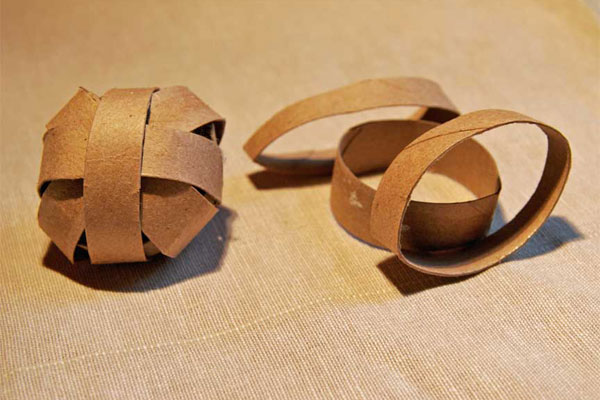
Credit: Deirdre Sullivan for HouseLogic
Recycling tip: The Humane Society also has a few ideas for repurposed cat toys: round plastic shower curtain rings make great toys for cats to bat around; plus large paper bags (never plastic) with the handles removed are perfect for a game of kitty hide and seek.
Give doggie dining a leg up
Large dogs, especially those in their senior years, can experience joint stress and other painful issues from repeatedly crouching down to reach their meals. Here’s an idea that alleviates discomfort by raising food and water bowls off the ground.
4. Eco-friendly canine feeding station: This clever food and water bowl set by For Love of a Dog gives canine meals a lift using small vintage school chairs. A foam gasket was added to stabilize the dog bowls; plus, the seats were water-sealed to protect the wood from spills.
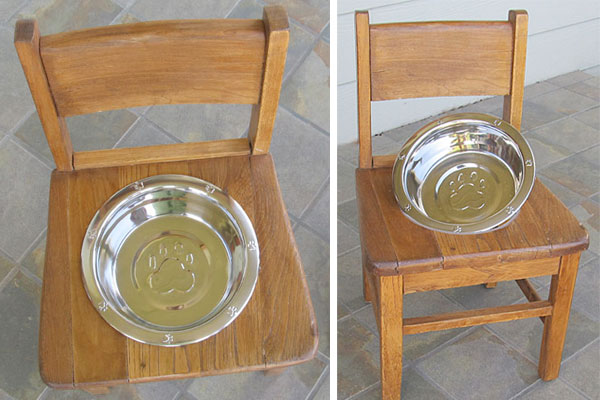
Credit: For Love of a Dog Jewelry & Gifts
Recycling tip: In addition to blankets and linens, many pet shelters will accept non-breakable dishes that can function as dog and cat bowls.
Give plastic bags a new leash on life
Here’s a green idea worthy of man’s best friend that turns pesky plastic bags into a dog leash.
5. Grocery bag dog lead: You’ll need a clasp for the dog’s collar to compete this project, plus a plastic clothesline clip, glue, and scissors. Keep in mind: While this leash does look sturdy, it is not suited for large dogs and aggressive leash-pullers.
Donation idea: You don’t have to be a dog owner to make one of these. As the video suggests, you can make a few leashes and donate them to a local animal shelter or rescue organization.





